View in other NatureServe Network Field Guides
NatureServe
Montana
Utah
Wyoming
Idaho
Wisconsin
British Columbia
South Carolina
Yukon
California
New York
Shadow Darner - Aeshna umbrosa
General Description
The Shadow Darner is a common and widespread member of the family Aeshnidae. Darners are among the largest and fastest-flying North American dragonflies, 2 1/4-4 3/4" (57-120 mm) long. Shadow Darners are found state wide from the mountians to the prairies with a subspecies in the east and in the western part of the state. Preferred habitat includes small slow-flowing forested streams, as well as shaded lakes, ponds, bogs, fens, swamps and ditches (Nikula et al. 2002, Paulson 2009, Dunkle 2000). In eastern Montana shaded riparian areas are probably key for this species to be present. Of the wedge shaded cerci darners with straight thoracic stripes, the shadow darner is more brown in color and narrower T-stripes, no face line, eastern form with small green abdominal spots, while western form has larger blue abdominal spots. Associated Wetland and Lotic ecological systems are numerous: Western Emergent Marsh, Northern Rocky Mountain Wooded Vernal Pool and the Rocky Mountain Subalpine-Montane Fen, Great Plains Open Freshwater Depressional Wetland, Perennial Praire Streams.
Diagnostic Characteristics
Of the wedge shaded cerci darners with straight thoracic stripes, the shadow darner is more brown in color and narrower T-stripes, no face line, eastern form with small green abdominal spots, while western form has larger blue abdominal spots.
Species Range
Montana Range
Range Descriptions

 Native
Native
Range Comments
The Shadow Darner has two distinctive subspecies, both of which occur in Montana. Aeshna umbrosa umbrosa occurs across the eastern plains and A. u. occidentalis is distributed in and west of the Rocky Mountains (Paulson 2009).
Observations in Montana Natural Heritage Program Database
Number of Observations: 130
(Click on the following maps and charts to see full sized version)
Map Help and Descriptions
Relative Density
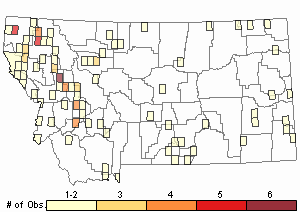
Recency
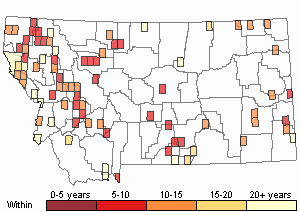
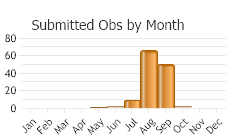
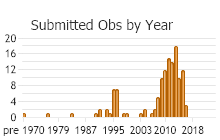
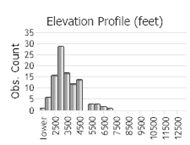 (Observations spanning multiple months or years are excluded from time charts)
(Observations spanning multiple months or years are excluded from time charts)
Habitat
Shadow Darners occupy small slow-flowing forested streams, as well as shaded lakes, ponds, bogs, fens, swamps and ditches (Dunkle 2000, Nikula et al. 2002, Paulson, 2009). This species is also found far from water in clearings, forest edges, and forested roads (Nikula et al. 2002).
National Vegetation Classification System Groups Associated with this Species
Wetland and Riparian
Alkaline - Saline Wetlands
Peatland
Riparian and Wetland Forest
Wet Meadow and Marsh
Food Habits
Larvae feed on a wide variety of aquatic insects, such as mosquito larvae, other aquatic fly larvae, mayfly larvae, and freshwater shrimp. They will also eat very small fish and tadpoles.
Adult- The dragonfly will eat almost any soft-bodied flying insect including mosquitoes, flies, small moths, mayflies, and flying ants or termites.
Ecology
This species is mostly active in shaded areas, hence the name Shadow Darner. It is known to feed out in the open very late into the evening even into darkness (Dunkle 2000, Paulson 2009).
Reproductive Characteristics
Shadow Darner males patrol close to the shoreline over open water often hovering for extensive periods. Females oviposit in the decaying wood of floating logs or submerged twigs and branches, even into moist trunks of trees and earthen banks of shoreline. This ovipositing behavior tends to lead to older females with missing or damages ceri (Dunkle 2000, Nikula et al. 2002, Paulson, 2009).
Stewardship Responsibility
References
- Literature Cited AboveLegend:
 View Online Publication
View Online Publication Dunkle, S.W. 2000. Dragonflies through binoculars: A field guide to dragonflies of North America. New York, NY. Oxford University Press. 266 pp.
Dunkle, S.W. 2000. Dragonflies through binoculars: A field guide to dragonflies of North America. New York, NY. Oxford University Press. 266 pp. Nikula, B., J. Sones, D.W. Stokes, and L.Q. Stokes. 2002. Stokes beginner's guide to dragonflies and damselflies. Boston: Little, Brown. 159 pp.
Nikula, B., J. Sones, D.W. Stokes, and L.Q. Stokes. 2002. Stokes beginner's guide to dragonflies and damselflies. Boston: Little, Brown. 159 pp. Paulson, D.R. 2009. Dragonflies and Damselflies of the West. Princeton University Press, Princeton. 535 pp.
Paulson, D.R. 2009. Dragonflies and Damselflies of the West. Princeton University Press, Princeton. 535 pp.
- Additional ReferencesLegend:
 View Online Publication
View Online Publication
Do you know of a citation we're missing? Oswald, R.A. 1979. Observations of distribution, abundance and production-related aspects of aquatic macroinvertebrates in natural thermal gradients. M.Sc. Thesis. Bozeman, Montana: Montana State University. 137 p.
Oswald, R.A. 1979. Observations of distribution, abundance and production-related aspects of aquatic macroinvertebrates in natural thermal gradients. M.Sc. Thesis. Bozeman, Montana: Montana State University. 137 p. Sater, S. 2022. The insects of Sevenmile Creek, a pictorial guide to their diversity and ecology. Undergraduate Thesis. Helena, MT: Carroll College. 242 p.
Sater, S. 2022. The insects of Sevenmile Creek, a pictorial guide to their diversity and ecology. Undergraduate Thesis. Helena, MT: Carroll College. 242 p.
- Web Search Engines for Articles on "Shadow Darner"
- Additional Sources of Information Related to "Insects"





